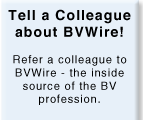| BV in the current economy: Is specialization required?
“You can’t be all things to all people,” Jim Andersen said at this week’s AICPA National Business Valuation Conference in San Francisco. “Don’t dabble in stuff. Whatever you do—do it well.” He divides the growth market for BV services into four categories, each with their own strengths and potential problems:
- Valuation for litigation. Marital dissolutions, dissenting shareholder and partnership disputes, economic damages and eminent domain proceedings: These are less fee-sensitive that traditional commodity work. But litigation can be tough on your schedule—and collecting fees particularly for divorce work can sometimes be a problem.
- Fair value for financial reporting. Purchase price allocations, impairment analyses, 409A and 123R valuations: all good work that requires specialized training. Most of the work is currently going to the larger firms. But if you get the work you may get two “cracks” at it—the actual 141 or 157 engagement and then the review of your report by the auditors’ firms. Fair value work is very DCF oriented, Andersen says, requiring “lots of assumptions”—and he cautions against the high exposure for liability.
- Business succession planning. Nearly every commentator is predicting a boom in this area as deferred baby boomer wealth transfers begin to occur. This is “very emotionally rewarding work” that is perfect for the general practitioner with ten to twenty years experience, who can act as “financial facilitator” for families in transition. Consulting opportunities include traditional M&A planning; “key employee” internal transfers; next generation family transfer and estate planning; and buy-sell valuations.
- Traditional commodity-driven valuations. Estate and gift, ESOPs, etc., are still presenting development opportunities—but you need to pick one or two and “do lots” to make money, Andersen says. “It gets tough, from a realization standpoint—and I might get 65% or 70% of my ‘normal’ rates for ‘filler’ stuff.”
Develop a marketing plan and consider hiring a PR consultant to help you realize it. In particular, business succession planning is “low hanging fruit” as baby boomers retire and the economy improves; for these tips and best practice techniques, see the January 2009 Business Valuation Update™.
BV Megatrends: Divisive factors, and a need to support your judgments
A common thread among the “BV Megatrends 2010” responses this week is a sense of increasing fractionalization—exactly at a time when the profession needs to unify. The lack of unity between the U.S.-based professional associations (AICPA/ASA/NACVA etc.) is still largely blamed, but now the “two tracks” situation caused by FMV vs. financial reporting work is exacerbating the situation. For example:
- The short-term increase in confusion caused by inexperienced valuation professionals as well as the bifurcation along [FMV and fair value] tracks is going to pressure the profession to unify and will lead to changes in the long term.
- If BV quality is to improve and if we are to prevent the same regulatory fate of the Real Estate world, we need to unify into one entity so that we will be taken seriously by the [outside authorities]. As of now we are a splintered group focusing on who is getting the membership revenue and who has the power to control.
- The BV dabbler will always exist in CPA firms, because they are unwilling to give up the incremental revenues. There will be an increasing divergence between practitioners working in multi-disciplinary firms, serving CPA/accounting clients, and those in a niche-focused firm serving more sophisticated needs.
- Think of the evolution of the semiconductor chip—from a scientific marvel to an inexpensive commodity. That’s our future…
“More science, less art.” The need for unification was supplemented by a second major trend toward increased dependence on empirical, quantitative data over qualitative. While one respondent commented that “we’re fooling ourselves if we think valuations are any more accurate just because we run them through extra databases analyses,” every one recognizes that unsupported conclusions will inevitably draw fire at some point. BV will always require judgment, but those judgments “can no longer come out of thin air,” said another.
Will BV ever become unified? Will the dabbler ever disappear? Add your voice to the continuing discussion; participate in the short, three-question BVMegatrends 2010 survey by clicking here.
Does a lost customer just before deal closing always mean “damages?”
What’s the impact on the purchase price—or more broadly—on overall value, when a target company loses a significant customer just before the deal closes?
“It depends on the characteristic of the customer,” according to Jeff Litvak and William Kennedy in their presentation, “Pitfalls to Avoid When Assessing Damages in M&A Disputes" at the AICPA BV Conference in California. Was the loss due to “normal” customer attrition or not?
Jeff and Bill laid out a five-point plan to help determine the severity of the customer loss:
1. Calculate the value of the customer to the business (i.e., contribution margin, operating profit, or customer EBITDA).
2. Ascertain subject company's (in this case, the target company’s) customer turnover rate.
3. Ask: Can the customer can be replaced? Will it be replaced?
4. Assess the impact of the loss on long-term capital structure.
5. Distinguish between an impact on only a few earnings periods versus an impact that extends into perpetuity.
Be wary of tax risks when assessing IP holding companies
When the Talbots Company went public in 1993, it loaned $103 million to a subsidiary to purchase the Talbots trademark and collect royalties, permitting the parent company to shave over $1.1 million from its annual state tax bill. But the holding company returned over 96% of royalties to its parent—and in Talbots v. Mass. Comm’r of Revenue (Sept. 29, 2009), the Massachusetts Appellate Tax Board found that the entire transaction lacked economic and business substance “aside from state tax avoidance.” The Board upheld the Commissioner’s decision to disallow any deductions the company claimed for royalty payments to the subsidiary and reattributed all the sub’s taxable royalties to Talbots.
“In short, the Massachusetts Board decided that any company using an intangible holding company structure (which usually includes a ‘shell’ company holding trademarks and patents) is at risk unless the intangible holding company has economic substance,” writes David R. Jarczyk, CFO at ktMINE, who alerted us to an analysis of the case by Ceteris. “This topic is a hybrid valuation/transfer pricing issue. Many of BVR’s valuation folks should review this topic when working on IP projects for their clients.”
Lack of “three approaches” gets experienced appraiser “Dauberted”
First, the federal district court found the defendants breached a twenty-year lease for a nursing home facility and owed the plaintiff/landlord over $370,000 in back rent. The landlord also claimed over $10 million in lost future payments, and presented a credentialed BV expert—the director of a valuation/litigation practice with more than 500 past valuations—to provide the proof. The defendants challenged the expert under Daubert, claiming she lacked specific healthcare experience and her report was unreliable.
The court quickly found her education and experience more than sufficient to qualify as an expert. But when it came to her report, the expert relied on just two emails regarding rental offers (both rejected by the landlord) and a Medicaid formula to conclude a fair rental value of $55,000 per month.
Where were the three approaches? “An appropriate appraisal of the nursing home facility should involve some combination of the three traditional valuation approaches—income, market (comparable sales), and cost,” the federal district court observed. “Nothing in the…record” suggested that the two email proposals represented fair market value, and the expert failed to explain how the Medicaid formula might determine private lease values or how she generally arrived at the $55,000 figure. “An expert must offer good reason to think that her approach produces an accurate estimate using professional methods, and this estimate must be testable,” the court said, before striking the expert’s report. Look for a complete abstract of Lock Realty Corp. v. U.S. Health LP (Sept. 14, 2009) in the January 2009 Business Valuation Update™. The full-text of the court’s opinion will be available at BVLaw™.
Don’t let Daubert pull the plug on your healthcare report!
The antidote? Tune into BVR’s continuing Teleconference Series on “Healthcare Valuation” (part 3 of 3), which concludes with a special look at hospitals, co-management agreements, and joint ventures. Featuring Don Barbo, Carol Carden, and Greg Anderson—all expert contributors to BVR’s Guide to Healthcare Valuation—this final installment will tackle these obstacles with an eye to how new regulations and reforms affect valuations in both consulting and litigation practices. It all begins Thursday, December 3 at 10:00 am PT/1:00 pm ET. Two CPE credits are available. To learn more or register, click here.
New six-month holding period transactions added to FMV Restricted Stock Study
After BVR’s free webinar on The FMV Restricted Stock Study™ last week with Lance Hall (see his slides here), FMV added new transactions to its fully searchable online database. This update—the second in the last four months—includes 43 transactions from the new six-month holding period. Lance explained the new data, how to use the database the way FMV Opinions does (complete with a practical case study); and why marketability discounts in excess of 50% can be appropriate (and supportable with the FMV data) given the recent volatility in the markets. Try an advanced search of the database now.
Internat’l Boards to issue revised Standards & more in 2010
At their annual general and separate meetings in Madrid November 5-7, the International Valuation Standards Board (IVSB) and the International Valuation Professional Board (IVPB) confirmed the following:
IVSB predicts new international standards by 2010. The IVSB is still updating the current (8th ed.) of the International Valuation Standards, aiming to: 1) include requirements for valuing all assets, liabilities and businesses; and 2) improve structure and drafting. The Board anticipates issuing an exposure draft by the second quarter 2010, with final publication of the revised standards by year’s end. Also slated for release next year: two guidance notes, Valuation of Intangible Assets and Valuation of Investment Property Under Construction. Finally, the Board approved a discussion paper on how to better communicate “the degree of certainty that can be attached to valuation estimates,” also slated for a 2010 release.
IVPB will issue standards guidance. Responding to the “clear demand for best practice guidance to support the consistent implementation of the IVS,” the IVPB will update several “guidance notes” (no longer “standards”), including those on The Cost Approach for Financial Reporting and Discounted Cash Flow, according to a release. Additional activities:
- The IVSB is collaborating with The Appraisal Foundation (TAF) to reduce current practice diversity in intangible asset valuation for financial reporting. Once TAF publishes its working group paper on Identification of Contributory Assets and the Calculation of Economic Rent, the IVSB will review and publish an exposure draft of an international version by Q2 2010.
- The IVPB is working on a joint, non-authoritative document addressing the auditor’s use of an “expert,” including a model agreement between the auditor and the valuator and a dialogue on maintaining independence.
- The IVPB is developing benchmarks to improve the standards of “valuation education around the world and to promote good ethical practices globally.” It has approved an exposure draft of a model Code of Ethics; it will also issue a discussion paper on the Definition of a Professional Valuer shortly.
IASB releases IFRS 9, Financial Instruments
Last week the International Accounting Standards Board (IASB) issued a new International Financial Reporting Standard (IFRS) on the classification and measurement of financial assets. Publication of IFRS 9 Financial Instruments completes the first of a three-part project to replace IAS 39 Financial Instruments: Recognition and Measurement. “The new standard enhances the ability of investors and other users of financial information to understand the accounting of financial assets and reduces complexity,” says the IASB release. The IASB received broad support feedback for its approach in IFRS 9, including the requirement to asses an entity’s business model first, to avoid considering the contractual cash flows of every individual asset. The Board also changed the proposed accounting for structured credit-linked investments and for purchases of distressed debt, and decided not to finalize requirements for financial liabilities, for which it expects to issue guidance in 2010.
The effective date for mandatory adoption of IFRS 9 Financial Instruments is January 1, 2013. A summary of the entire IAS 39 replacement project—including posted feedback and updates—is available here.
Holiday hiatus: BVWire will be taking a break during Thanksgiving week. From every one at BVR, enjoy the holidays.
To ensure this email is delivered to your inbox,
please add editor@bvwire.com to your e-mail address book.
We respect your online time and privacy and pledge not to abuse this medium. To unsubscribe to BVWire™ reply to this e-mail with 'REMOVE BVWire' in the subject line or click here. This email was sent to %%emailaddress%%
Copyright © 2009 by Business Valuation Resources, LLC
BVWire™ (ISSN 1933-9364) is published weekly by
Business Valuation Resources, LLC
Editorial Staff | Advertise in the BVWire | Copyright Notice
|




